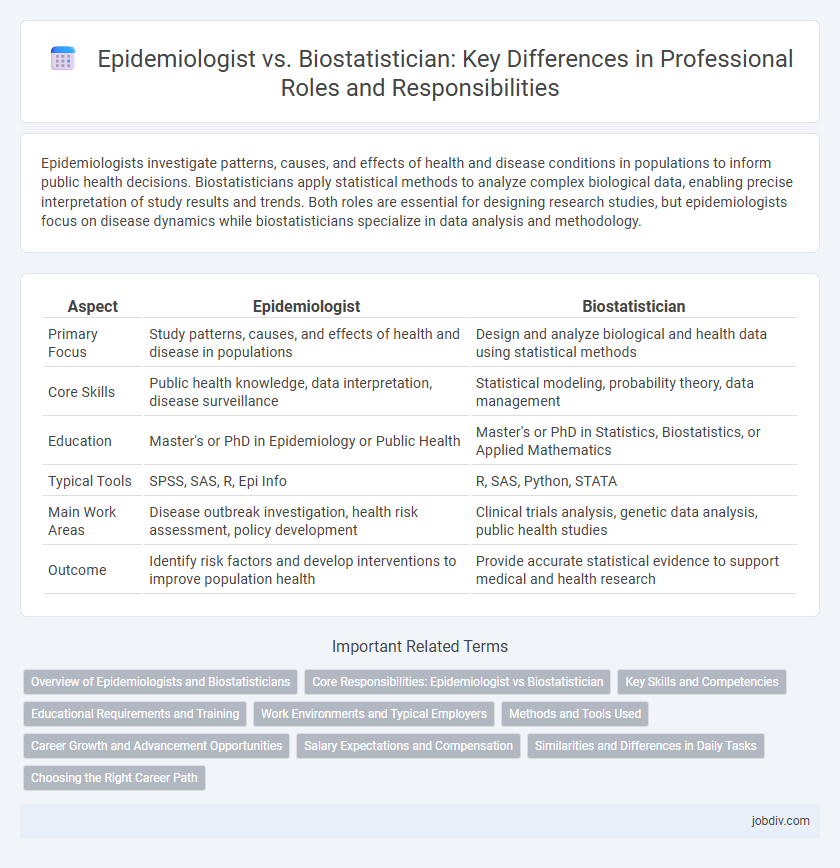Epidemiologists investigate patterns, causes, and effects of health and disease conditions in populations to inform public health decisions. Biostatisticians apply statistical methods to analyze complex biological data, enabling precise interpretation of study results and trends. Both roles are essential for designing research studies, but epidemiologists focus on disease dynamics while biostatisticians specialize in data analysis and methodology.
Table of Comparison
| Aspect | Epidemiologist | Biostatistician |
|---|---|---|
| Primary Focus | Study patterns, causes, and effects of health and disease in populations | Design and analyze biological and health data using statistical methods |
| Core Skills | Public health knowledge, data interpretation, disease surveillance | Statistical modeling, probability theory, data management |
| Education | Master's or PhD in Epidemiology or Public Health | Master's or PhD in Statistics, Biostatistics, or Applied Mathematics |
| Typical Tools | SPSS, SAS, R, Epi Info | R, SAS, Python, STATA |
| Main Work Areas | Disease outbreak investigation, health risk assessment, policy development | Clinical trials analysis, genetic data analysis, public health studies |
| Outcome | Identify risk factors and develop interventions to improve population health | Provide accurate statistical evidence to support medical and health research |
Overview of Epidemiologists and Biostatisticians
Epidemiologists investigate patterns, causes, and effects of health and disease conditions in defined populations, utilizing field data and public health records to design studies and inform interventions. Biostatisticians apply statistical theories and methods to analyze complex biological data, ensuring accuracy in interpreting epidemiological findings and guiding evidence-based decision-making. Both roles collaborate closely in public health research, with epidemiologists focusing on disease trends and biostatisticians providing quantitative analysis to validate results.
Core Responsibilities: Epidemiologist vs Biostatistician
Epidemiologists investigate patterns, causes, and effects of health and disease conditions in defined populations, designing studies to track disease outbreaks and evaluate public health interventions. Biostatisticians specialize in applying statistical techniques to analyze complex biological data, ensuring accurate interpretation through modeling, hypothesis testing, and data management. Both roles collaborate closely, with epidemiologists focusing on study design and public health implications, while biostatisticians provide rigorous quantitative analysis to validate findings.
Key Skills and Competencies
Epidemiologists excel in disease surveillance, outbreak investigation, and public health data interpretation, leveraging skills in study design, risk assessment, and causal inference. Biostatisticians specialize in statistical modeling, data analysis, and algorithm development, with strong competencies in biostatistics software, probability theory, and experimental design. Both roles require proficiency in data management, critical thinking, and collaboration across multidisciplinary teams to address complex public health challenges.
Educational Requirements and Training
Epidemiologists typically require a master's degree in public health (MPH) or epidemiology, with advanced roles often demanding a PhD or MD. Biostatisticians generally need a strong foundation in mathematics or statistics, often obtained through a master's or doctoral program focused on biostatistics or applied statistics. Both professions emphasize rigorous training in data analysis and research methodologies relevant to public health and medical studies.
Work Environments and Typical Employers
Epidemiologists typically work in public health departments, research institutions, hospitals, and government agencies, focusing on disease prevention and population health studies. Biostatisticians are often employed by pharmaceutical companies, academic research centers, and healthcare organizations, providing statistical analysis for clinical trials and biomedical research. Both professions frequently collaborate within universities and federal agencies such as the CDC and NIH to advance medical and health-related knowledge.
Methods and Tools Used
Epidemiologists primarily use study designs such as cohort, case-control, and cross-sectional studies, employing tools like surveillance systems, geographic information systems (GIS), and statistical software to track disease patterns and risk factors. Biostatisticians focus on advanced statistical modeling, data analysis, and interpretation, utilizing software such as R, SAS, and Stata to develop algorithms for clinical trials, public health research, and genetic studies. Both professions rely heavily on quantitative methods but differ in their application focus, with epidemiologists emphasizing disease occurrence and biostatisticians specializing in data methodology and inference.
Career Growth and Advancement Opportunities
Epidemiologists often advance through roles in public health agencies, research institutions, and healthcare organizations, with opportunities to lead outbreak investigations, design population health studies, and influence health policy. Biostatisticians experience career growth by specializing in complex data analysis, clinical trial design, and predictive modeling, frequently progressing to senior analyst or data science leadership positions in pharmaceutical companies, government, and academia. Both careers benefit from advanced degrees and continuous skill development, but epidemiologists may have broader roles in policy and program management, while biostatisticians focus on quantitative methods and statistical innovation.
Salary Expectations and Compensation
Epidemiologists typically earn a median annual salary of approximately $78,000, reflecting their expertise in disease patterns and public health research. Biostatisticians command higher compensation, with median salaries around $95,000, driven by the critical role of advanced statistical analysis in clinical trials and health data interpretation. Salary variations depend on factors such as education level, industry sector, geographic location, and years of experience.
Similarities and Differences in Daily Tasks
Epidemiologists and biostatisticians both analyze health data to understand disease patterns and inform public health decisions, but epidemiologists primarily design studies and investigate disease outbreaks, while biostatisticians focus on applying statistical methods to interpret complex health data. Daily tasks for epidemiologists include data collection, fieldwork, and hypothesis testing, whereas biostatisticians develop and implement statistical models and software to analyze datasets. Both roles require strong analytical skills and collaboration with healthcare professionals to translate data into actionable public health strategies.
Choosing the Right Career Path
Epidemiologists analyze patterns, causes, and effects of health and disease conditions in populations, focusing on public health interventions and disease prevention strategies. Biostatisticians specialize in designing studies and applying statistical methods to analyze health data, ensuring accurate interpretation and decision-making in medical research. Choosing the right career path depends on whether one prefers fieldwork and disease investigation (epidemiology) or quantitative data analysis and methodological development (biostatistics).
Epidemiologist vs Biostatistician Infographic

 jobdiv.com
jobdiv.com